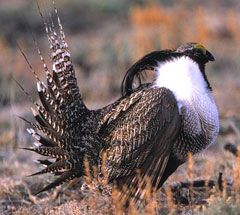
DENVER — A rare bird found only in Colorado and Utah will stay on the endangered species list, at least for now, a U.S. district judge said Friday.
The judge upheld a 2014 decision by the U.S. Fish and Wildlife Service to protect the Gunnison sage grouse as a threatened species and to designate more than 2,200 square miles (5,800 square kilometres) of land as critical habitat.
State and county governments in Colorado and Utah as well as a Colorado ranching group had challenged the decision, arguing the best scientific data did not support threatened status.
They also questioned whether all of the land classified as critical habitat was suitable for the birds.
“We’re disappointed that the court didn’t recognize efforts of Gunnison County (Colorado), landowners and the state to help the species, and it’s a significant effort,” said John Swartout, a policy adviser to Colorado Gov. John Hickenlooper.
Swartout and others said no decision had been made on whether to appeal.
Fish and Wildlife Service spokeswoman Jennifer Strickland said the agency was pleased by the ruling and plans to keep working with local and state governments and other groups.
Environmental groups that intervened in the case said they were happy.
“We’re relieved that desperately needed protection for these unique birds will stand,” said Ryan Shannon, a staff attorney at the Center for Biological Diversity.
The Fish and Wildlife Service said only about 4,700 Gunnison sage grouse remained in 2014 when it was listed as threatened and put the number at 5,000 in 2017. Some environmental groups say the number is much smaller now.
The Gunnison grouse is related to the larger and more numerous greater sage grouse.
Greater sage grouse can be up to 2 feet (61 centimetres) tall and weigh 5 pounds (2.25 kilograms). The Gunnison birds are about one-third smaller.
Both are ground-dwelling birds known for the males’ elaborate mating rituals.
Under the Endangered Species Act, a threatened species is considered likely to be pushed to the brink of extinction soon. It is less serious than endangered, which means a species is on the verge of extinction now and requires stronger protection.
The U.S. Supreme Court will hear arguments Monday in an Endangered Species Act case in Louisiana with similarities to the Gunnison grouse case, said David Halverson, a lawyer for the state’s Public Lands Policy Coordinating Office.
The Fish and Wildlife Service designated timberland in Louisiana as critical habitat for an endangered frog, but opponents say the frog has not lived in that state since 1965.
Utah argues that some of the land designated as critical habitat for the Gunnison grouse is not suitable for the bird, Halverson said.
“It’s hard to say it’s essential for the conservation of the species if the species can’t live there,” he said.
Halverson said Utah wants to save the bird but believes it can be done better outside the framework of the Endangered Species Act.
The law has been under increasing attack by Republicans, who say it is too restrictive, hurts economic growth and leads to yearslong court battles.
Calls for change grew louder this week after a federal judge in Montana restored protections for grizzly bears in and around Yellowstone National Park. That delayed grizzly hunts that had been planned in Wyoming and Idaho.
The GOP-dominated House Natural Resource Committee began considering changes Wednesday that supporters said would make the law work better and eliminate obstacles to economic progress. Critics said they would weaken the law by shifting power to state and local governments and away from federal scientists.